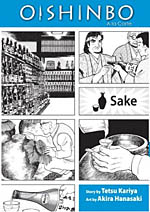 Written by Tetsu Kariya
Written by Tetsu Kariya
Art by Akira Hanasaki
272 pages, black and white
Published by Viz
When I read Oishinbo: A la carte: Japanese Cuisine earlier this year, I enjoyed it. A series all about different foods, going for the generic theme of Japanese cuisine for the first volume seemed like a good way to kick off these specially themed, best-of compilations from this series that’s run for over 25 years now. Now that I’ve read the second volume, Sake, I’m starting to really see just what Oishinbo is really capable of—and how much better the second volume really is.
To the uninitiated, sake is merely Japanese wine, and a product that’s slowly been on the decline in Japan. As Yamaoka and his colleagues continue to research the "Ultimate Menu" for their newspaper, the subject of sake is finally brought up—opening a whole can of worms as they discover not only the wide varieties of sake available, but how Japan itself seems determined to destroy their special and unique form of alcohol.
I’ll admit it, I’ve only had sake a few times, and some varieties were definitely better than others. So it wasn’t until I’d read Oishinbo: Sake that I began to really understand not only the wide varieties that exist of sake, but the strange history that modern sake has endured. I certainly didn’t know that so much of sake these days, for instance, isn’t really sake but rather a drink that is only about one-third sake that’s been combined with massive amounts of distilled alcohol, glucose, and sugar. So while many of the larger manufacturers churn out this cheap "sanzoshu sake" that makes people think all sake is like that, it’s many of the smaller breweries that are putting out good quality, "real" sakes. From this alone, I was really drawn into the book, and I actually ended up marking some of the pages with sticky notes so that I could actually take Oishinbo: Sake with me to a local Japanese grocery store to try and hopefully find some of this higher-quality sakes.
What also really grabbed my attention, though, was that half of Oishinbo: Sake is one long six-part story as Yamaoka and his friends try and save the small Edo Ichiban sake brewery from being turned into another maker of sanzoshu sake. What’s great about the story is that it has its ups and downs, really letting both the story build as well as getting to the heart of what sake’s strengths really are. Seeing this extended story impressed me in no small part because while up until now I’d been appreciating all of the food knowledge that Oishinbo has brought me, this was the first time where I really started understanding and clicking with the characters as more than just a method to deliver all of these interesting vignettes about food. The Sake volume also really helps paint a picture of modern Japan’s alcohol culture being invaded by the rest of the world, and how it’s changing the way things are drank and produced; it’s a fascinating little side story about culture in general (not just eating) that made me that much more intrigued.
While the art is still serviceable at best (it draws the food wonderfully, and that’s what it’s really here for), I have to say that Oishinbo has gone from a fun little series to read to one that I’m genuinely dying to read more about, all in just two volumes. Now that we’ve seen the narrower focus that the Oishinbo: A la carte best-of compilations can bring, I’m really eyeing the line-up of future volumes with great excitement. At the same time, there’s stuff in this Sake collection that makes me really want to go out and experiment with sake. Can a good sake really go well with just about any kind of seafood? I’m dying to find out. Happy eating, one and all.
Purchase Link: Amazon.com
